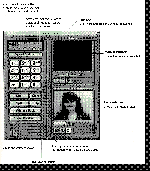
 |
||||

 Contents
Contents
The package comes with a video board, an ISDN board, a camera, a headset plus software diskettes and documentation. It should be noted that two expansion slots are needed in the PC for the video and ISDN boards.
The ProShare Video System is designed mainly for use with
"The Intel ProShare Personal Conferencing Video System lets you use your computer for a video conference with another ProShare Video System user. You can also share an application with the person you called."(ProShare User's Guide, P.1)
The shared notebook has similar features to the whiteboards described previously; i.e it allows copying of files into the notebook, text and shapes to be added, snapshots of other windows to be taken, etc.
Strictly speaking, the shared application tool in ProShare is part of the shared notebook. There are two ways of sharing an application. The first one is called Host Edit in which one person starts the Windows (or DOS) application and then asks for it to be shared. That person continues to control the application and the other person can only watch. The other way is called Host and Guest Edit in which one person starts and shares the application and both participants can provide input to the application. This means that the shared application tool in ProShare does not have quite the same functionality as Showme SharedApp. It does not allow the participant who is not the initiator to keep exclusive control of an application (which is an extremely useful requirement in a helpdesk environment). ProShare also allows only two participants whereas ShowMe allows multiple participants.
We feel that ProShare's procedure for starting a shared application is more intuitive than the cumbersome way provided by ShowMe.
A Dialling List can be created as an 'aide-memoire' to make it easy to dial people again. The Dial List contains names and corresponding phone numbers. One good feature of ProShare is that the names and numbers of people who call are automatically added to the callee's list, unless the callee requests the system not to do this. Another feature is that the last five numbers dialled are up front in the list.
ProShare also has an address book feature - this is probably surplus to our particular needs since the Dialling List is sufficient to call people. However, the address book would be of interest to many departments, since it allows bitmaps (e.g. pictures of people) to be added and documents to be linked to the users' record, which can itself have fields that contain not only names and numbers, but also home addresses, etc.
ProShare's Windows interface makes it attractive to the vast number of people who only know Windows. As one would expect, when running the shared notebook, it is possible to use Windows features such as copying pictures from other Windows applications to the clipboard and then pasting them onto the shared notebook. Another feature is that documents that have been created in an OLE (Object Linking and Embedding) application can be linked to the shared notebook.
However, it is recommended in the manual that a Dialling List is created and then all one has to do is to select the correct name and phone number from the list.
When a call is made, the other participant has to be in 'listening' mode before the call can be answered; i.e. on the other PC, there must either be an icon for ProShare Video Listening minimised at the bottom of the screen or ProShare itself must be running.

Other suggestions are to close all other applications and to use plain Windows wallpaper as the background to reduce colour flash. The performance is also improved if the video windows are reduced in size and if the quality of the picture is changed from high to low.
The ProShare package contains a special headset which consists of a microphone and an earphone; using this helps to reduce the echo. It is possible to connect speakers so that other people in the room can hear what is being said but of course this increases the chance of echoing.

 Contents
Contents
Graphics Multimedia Virtual Environments Visualisation Contents